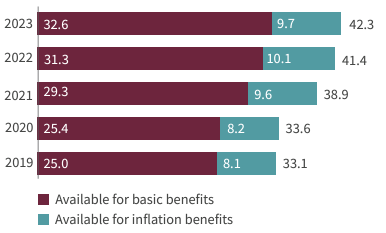Adjusting for inflation - Public Service

Adjusting for inflation
Inflation adjustments added to your pension can help preserve your buying power throughout your retirement.
Just as you may receive a pay raise while working that helps offset increases in the cost of living, your future pension payments may increase from time to time thanks to inflation adjustments. These adjustments help your pension keep pace with increases in the cost of living.
The Public Service Pension Board of Trustees has granted inflation protection according to the plan rules every year to date. However, although inflation adjustments have been granted annually, they aren't a guaranteed benefit. You may not receive an inflation adjustment each year, and the amount may change from year to year. However, once you receive an adjustment, it becomes part of your basic lifetime pension.
When granted, inflation adjustments are also applied to the bridge benefit and temporary annuity portion of your pension, if applicable.
Each year, the board carefully considers several factors to decide whether to grant an inflation adjustment and, if so, its value.
Net assets available for benefits ($ billions) as at March 31

To understand how this works, it helps to know that your pension is funded through two accounts: the basic account and the inflation adjustment account.
Basic account = funding for basic pension
Member and employer contributions, and investment returns fund the basic account. Your basic pension is paid each month from funds in the basic account.
Inflation adjustment account = funding for inflation adjustments
The inflation adjustment account is separate from the basic account. Member and employer contributions, and investment returns also fund this account.
While your basic pension is based on a formula, inflation adjustments are not guaranteed. They are based on the funds available in the inflation adjustment account. If the board grants an adjustment in a particular year, funds from the inflation adjustment account are transferred to the basic account so they can be applied to your basic pension, and bridge benefit and temporary annuity, if applicable.
Calculating inflation adjustments
The board seeks to ensure that inflation adjustments are sustainable over the long term. Inflation adjustments are not guaranteed; they are based on:
- Changes in the Canadian consumer price index (CPI) averaged over the 12-month period from November to October
- Funds available in the inflation adjustment account of BC's Public Service Pension Plan
Each year, the board considers changes to CPI and the available funds in the inflation adjustment account. If the board grants an inflation adjustment, it takes effect the following January.
You may have noticed some pension plans have inflation adjustment amounts that are different from yours. That’s because BC public sector pension plans have different ways of calculating the inflation adjustment. In general, different calculation methods generate different annual inflation adjustment amounts. The good news is that no method produces results that are consistently higher or lower than the others over multiple years.
Calculation methods
The inflation adjustment is calculated using monthly rates from the CPI. Your plan uses the annual percentage change in the average CPI. With this method, the inflation adjustment is based on the annual percentage change in the 12-month average CPI from one year to the next. Each year, that average, from November to October, is compared to the average for the 12-month period that came before it. The difference between the two 12-month periods becomes the inflation adjustment.
Other BC public sector pension plans may use the percentage change between September CPIs. With this method, the inflation adjustment is based on the percentage change between the current year’s September CPI and the previous September’s CPI.
Example
In some years, one method generates a higher inflation adjustment; in some years the other method generates a higher amount.
Inflation adjustment methodologies comparison (%)

Because of COLA/inflation adjustment caps, some plans did not grant the full COLA/inflation adjustment amounts determined by their plan's methodology in certain years.
 Inflation adjustments add up over time. For example, if you had started receiving an annual pension of $20,000 in 2004, your annual pension in 2024 would be $30,757.
Inflation adjustments add up over time. For example, if you had started receiving an annual pension of $20,000 in 2004, your annual pension in 2024 would be $30,757.
Related content for inflation adjustments article
